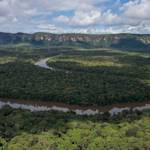Fort Jefferson National Monument, world's first MPA
1935 CE • Florida, USA
"Almost 70 miles west of Key West, Fla., lies a cluster of seven islands, composed of coral reefs and sand, called the Dry Tortugas. With the surrounding shoals and water, they make up Dry Tortugas National Park, an area noted for bird and marine life and shipwrecks. Fort Jefferson, its central cultural feature, is the nation's largest 1800s masonry fort . . . In 1908 the area became a wildlife refuge to protect the sooty tern rookery from egg collectors." Considered the world's first marine protected area, Fort Jefferson National Monument was proclaimed in 1935 and "redesignated in 1992 as Dry Tortugas National Park to protect its nationally significant scenic, cultural, marine, and scientific values for the education and inspiration of the public. Not least among its natural treasures are its namesakes, the endangered green sea turtles and threatened loggerhead turtles that nest here." Additionally, the island is a critical flyway between the United States and South America for nesting birds, with many gull, terns, and other migratory birds wintering in the area.
Elizabeth A. Pendleton, E. Robert Thieler and S. Jeffress Williams, "Dry Tortugas National Park," NPS History eLibrary, 2005.
Image: Florida Fish and Wildlife via Flickr, CC BY-ND 2.0 DEED Attribution-NoDerivs 2.0 Generic


Learn about Maya Lin’s fifth and final memorial: a multi-platform science based artwork that presents an ecological history of our world - past, present, and future.

Discover ecological histories and stories of former abundance, loss, and recovery on the map of memory.

Learn how we can reduce our emissions and protect and restore species and habitats – around the world.

See how art can help us rethink the problems we face, and give us hope that each one of us can make a difference.

Help make a global memorial something personal and close to home. Share your stories of the natural world.


